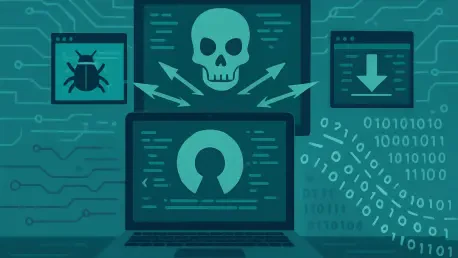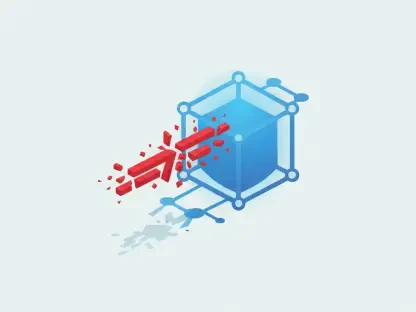In an era where software development increasingly depends on collaborative and accessible resources, a troubling trend has emerged as a significant risk to cybersecurity across industries, with malicious actors capitalizing on the inherent trust and widespread adoption of open-source software (OSS) repositories to distribute harmful code. This compromises sensitive data and disrupts operations on a global scale. These platforms, often seen as cornerstones of innovation due to their accessibility and community-driven nature, have become prime targets for attackers seeking to infiltrate development workflows. Recent analyses reveal a persistent challenge as adversaries exploit vulnerabilities in popular ecosystems like NPM and PyPI, embedding malicious scripts that evade detection and steal critical information. This growing issue underscores an urgent need for heightened vigilance and robust security measures to protect the integrity of software supply chains, as the scale and sophistication of these attacks continue to escalate.
Unveiling the Tactics of Cyber Adversaries
Sophisticated Exploitation of Trusted Platforms
The reliance on third-party packages in modern software development has opened a gateway for threat actors to introduce malicious code through trusted OSS platforms. These repositories, integral to countless projects worldwide, are often perceived as safe due to their community oversight, yet this trust is precisely what attackers exploit. By targeting ecosystems like NPM and PyPI, adversaries embed harmful scripts within seemingly legitimate packages, designed to execute stealthily during installation. Such tactics often involve data exfiltration, harvesting personal details, browser credentials, and even cryptocurrency wallets without raising suspicion. A comprehensive scan of over 1.4 million NPM packages and 400,000 PyPI packages in a recent quarter uncovered a significant volume of malicious artifacts, highlighting the scale of this threat. These findings emphasize how attackers leverage minimal file structures and absent linked repositories to blend in, making it challenging for developers to discern malicious content from benign contributions in the fast-paced development cycle.
Evolving Obfuscation Techniques
As security measures improve, so too do the methods employed by cybercriminals to conceal their intentions, rendering detection increasingly difficult. A notable uptick in the complexity of obfuscation has been observed, with attackers employing multiple layers of encryption and code concealment to thwart both static and dynamic analysis. This trend marks a shift toward more sophisticated evasion tactics, where malicious scripts are buried within setup or install files, often mimicking legitimate libraries. For instance, specific PyPI packages have been found to execute credential theft through cleverly disguised scripts, while certain NPM packages use obfuscated JavaScript to steal browser profiles and passwords, exfiltrating data to remote servers controlled by attackers. These techniques not only delay identification but also complicate the efforts of security teams to trace and mitigate threats. The persistent adaptation of these methods illustrates a clear intent to stay ahead of evolving defenses, posing a continuous challenge to cybersecurity professionals tasked with safeguarding digital environments.
Strategies to Counter the Growing Menace
Strengthening Defenses Against Supply Chain Threats
Addressing the pervasive issue of OSS supply chain attacks requires a multi-faceted approach that prioritizes proactive monitoring and risk awareness within development pipelines. Organizations must adopt a mindset of vigilance, recognizing that the expanding attack surface of OSS ecosystems offers numerous entry points for malicious actors. Implementing advanced scanning tools to detect harmful dependencies before they are integrated into projects is a critical step in mitigating risks. Additionally, security solutions such as antivirus detections for identified malicious packages and web filtering to block associated URLs can serve as essential barriers against infiltration. Services tailored for development security, which focus on preventing harmful dependencies from entering the pipeline, further enhance protection. By fostering an environment of continuous scrutiny and leveraging cutting-edge technology, companies can significantly reduce the likelihood of falling victim to stealthy attacks that exploit the trust inherent in open-source communities.
Incident Response and Adaptive Security Measures
Beyond preventative strategies, the importance of rapid response mechanisms cannot be overstated when dealing with potential breaches stemming from OSS vulnerabilities. Establishing a robust incident response framework ensures that any suspected compromise is addressed promptly, minimizing damage and preventing further exploitation. Engaging specialized teams to investigate and contain incidents as soon as they are detected is vital for maintaining operational integrity. Moreover, staying informed about emerging threats and adapting security postures accordingly allows organizations to counter the evolving tactics of threat actors. The enduring nature of supply chain attacks, characterized by discreet exfiltration and impersonation, necessitates ongoing education for developers to recognize red flags in dependencies. By combining immediate action with long-term adaptive strategies, businesses can build resilience against the sophisticated and persistent methods employed by attackers, ensuring that their development environments remain secure amidst an ever-changing threat landscape.









